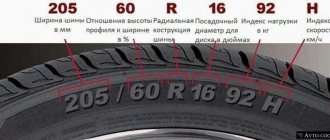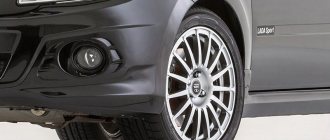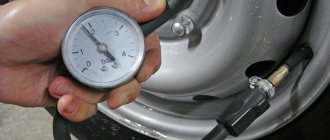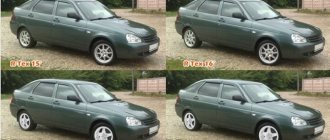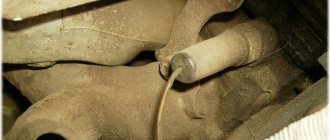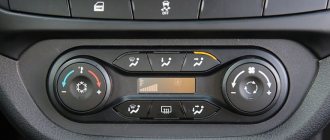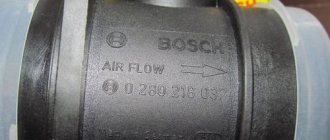Why check tire pressure?
The catalyst for many accidents is worn-out car tires, and the most serious tread damage occurs on overinflated or low tires.
In the first case, the center of the treadmill burns out - because of this defect, the braking distance increases and the number of accidents during emergency braking increases. In the second case, the edge of the tread wears off - this defect leads to loss of traction when maneuvering. However, incorrect tire pressure can lead to unpleasant consequences not only in the long term. A car driver who ignores the wheel control system signals faces the following problems:
- loss of dynamics - accelerating to 100 km/h in 7-10 seconds will no longer be possible;
- decreased controllability - the car skids when turning even on a dry road;
- increased fuel consumption - instead of the expected 4.6-9.8 per 100 km, the Mazda CX5 will “eat” up to 8-12 liters.
If the tire pressure monitoring sensor is on on the dashboard, do not ignore it, but try to deal with the problem that has arisen.
Why You May Need to Disable TPMS
This electronic system indirectly measures the pressure in the vehicle's tires, as well as the temperature. Typically it is software built into the ABS control unit and wheel speed sensors.
The control unit receives a wireless signal from 4 sensors about the angular speed of the wheels. If the tire pressure drops, its radius decreases slightly, and so does the angular speed of rotation.
After a symbol indicating an error in the pressure control system is displayed, or a constant alarm indicating low pressure in one of the wheels, many drivers prefer to remove the malfunction notification from the dashboard. Periodic (continuous) display of the symbol distracts attention from the instrument readings.
Troubleshooting options
Alternatively, the car owner can purchase new sensors for winter tires, which cost 3,000–4,000 rubles. per piece or replace the “original” ones with new wheels. You will need to go to a service station and remove the tires to get to the sensors. All this is troublesome and expensive.
Different brands of cars come with different software, so your shutdown options may vary. Let's look at how to disable tire pressure sensors in accessible ways:
Tip: It is better to leave the pressure monitoring system in working order, as it can prevent an accident on the road if the tire is quickly punctured while the car is moving at high speed.
Video on the topic
How to disable sensors that measure tire pressure Link to main publication
Tire pressure sensor Mazda CX 5: characteristics and code
Tire pressure sensor
Statistics of accidents on the road eloquently show: one of the most common causes of danger on the road is tires. In winter, this may be due to lost studs or worn out tread pattern. Traditionally, less attention is paid to summer tires, but this is also an important safety parameter.
However, pressure plays an equally important role in ensuring peace of mind on the road. It is not by chance that the manufacturer puts the recommended indicators in the instruction manual. It varies depending on the type of body, the weight of the car, its speed characteristics and, finally, the size of the wheels.
Modern, innovatively equipped cars are equipped with intelligent systems that specialize in monitoring pressure indicators. They are necessary to ensure rapid response to important changes in tires.
Summer tires for Mazda CX 5
In this case, the pressure value depends on this indicator.
2.3 bar is recommended for 17th and 18th wheels. R19 – 2.5 bar.
The pressure sensor (TPMS) is activated when the engine starts. It lights up when ignited and goes out if everything is in order. If the pressure in any wheel does not correspond to the regulated pressure, the on-board computer highlights it in red.
In the catalog list, this spare part has article number BHB6-37-140. The quality of the product is guaranteed by Siemens (VDO) France.
According to forums and reviews from car enthusiasts, with correct installation and strict adherence to operational nuances, the uninterrupted service life of the sensor is from 8 years.
However, there is no specific control system option for the CX-5. The concern distributes one type of sensor to almost the entire model range.
When purchasing a part, a nipple is included in the kit. Installation of the sensor is accompanied by mandatory binding and activation.
Mazda has an automatic binding type. This happens during a test drive.
Entering the device binding mode occurs by resetting the previous settings via the on-board computer. On new versions of cars, the sensor is built in without the need for this procedure.
In the case when the sensor is changed in the spare wheel, it is linked using the diagnostic console. The identifier of a specific device is entered into the car’s intelligent system.
How does the Mazda CX5 tire pressure monitoring system work?
The wheel control system can be direct or indirect. The first technology relies on controllers built into the tire. The second system operates with data on the size of the wheel and the associated angular velocity. Mazda's designers opted for an indirect TPMS system.
The main components of the TPMS system are software and four sensors that monitor the angular speed of the wheel. A flat or overinflated tire changes its outer diameter, causing the angular speed to decrease or increase. The control sensor checks this indicator while driving, and the software compares the received data with the basic values. If the basic values deviate, the “Tire pressure error” signal lights up on the dashboard.
For the TPMS system to work, you need to initialize the software and sensors. Without prior activation and calibration, the number of false alarms increases (the signal will remain on even if the tire is correctly inflated).
How do sensors work in a Mazda CX-5?
In the Mazda CX-5, tire pressure monitoring (TPMS) is carried out simultaneously on all sides when the engine is started. The sensor lights up after the engine starts, going out after a few seconds. During this time, real indicators are checked and compared with the regulated ones. If there are no deviations, the system switches to passive tracking mode. There is no control during parking. Activation of the sensor while driving signals the need for immediate adjustment. After adjusting the indicator to the standard value, the signal light goes out.
Read also: Niva internal grenade seal
The system may fail or hide the problem when:
1) simultaneous use of different types of tires or unsuitable wheel sizes for Mazda CX-5.
2) Tire puncture.
3) Driving on bumpy or icy roads.
4) Driving at low speeds.
5) Traveling short distances.
According to the diameter of the tires, the pressure in the Mazda CX-5 r17 tires should be 2.3 atmospheres; for the R19, 2.5 atmospheres is considered the norm. The indicator is identical for the front and rear axles of the car. These values are regulated by the manufacturer and specified in the technical documentation.
Tires can deflate over time by exchanging air with the environment through the pores of the rubber. In summer tires for the Mazda CX-5, the pressure increases with increasing temperature, but in winter this figure drops by an average of 0.2-0.4 atmospheres per month.
The operation of the sensors is not affected by which tires are installed on the Mazda CX-5 (R17 or R19). Even when replacing tires or wheels, the system automatically changes settings and calibrates data for new operating conditions.
Regular tire pressure is the key to safety on the road and extends the life of the rubber. The electronic TPMS system in the Mazda CX-5 promptly informs the driver of deviations from regulated standards.
Insufficient or too high tire pressure leads to reduced vehicle safety, deterioration of dynamic characteristics and causes increased fuel consumption. Therefore, the Mazda CX 5 uses special sensors.
They promptly detect and inform the driver about deviations in tire pressure from the norm.
Popular tire models
- Yandex.Market rating: Yandex.Market: 4.5
Goodyear Eagle Sport TiresSeasonality: summer Spikes: no Diameter: 14 / 15 / 16
- Yandex.Market rating: Yandex.Market: 4.5
Goodyear UltraGrip Ice+ tires
Seasonality: winter Spikes: no Diameter: 14 / 15 / 16 / 17
- Yandex.Market rating: Yandex.Market: 4.5
Goodyear EfficientGrip Performance Tires
Seasonality: summer Spikes: no Diameter: 15 / 16 / 17 / 18 / 19 / 20
- Yandex.Market rating: Yandex.Market: 4.5
Goodyear UltraGrip Ice 2 tires
Seasonality: winter Spikes: no Diameter: 14 / 15 / 16 / 17 / 18 / 19
- Yandex.Market rating: Yandex.Market: 4.5
Goodyear Vector 4Seasons tires
Seasonality: all-season Spikes: no Diameter: 14 / 15 / 16 / 17 / 18
- Yandex.Market rating: Yandex.Market: 4.5
Goodyear Eagle Sport TZ tires
Seasonality: summer Spikes: no Diameter: 16 / 17 / 18
- Goodyear UltraGrip Arctic 2 tires
Seasonality: winter Spikes: yes Diameter: 16 / 17 / 18 / 19
- Yandex.Market rating: Yandex.Market: 4.5
Goodyear UltraGrip Ice SUV Tires
Seasonality: winter Spikes: no Diameter: 16 / 17 / 18 / 19 / 20
- Goodyear UltraGrip Arctic 2 SUV Tires
Seasonality: winter Spikes: yes Diameter: 17 / 18 / 19 / 20 / 21
- Yandex.Market rating: Yandex.Market: 4.5
Goodyear Wrangler All-Terrain Adventure tires with Kevlar
Seasonality: summer Spikes: no Diameter: 15 / 16 / 17 / 18 / 19 / 20
- Yandex.Market rating: Yandex.Market: 5
Goodyear Eagle Sport SUV TZ tires
Seasonality: summer Spikes: no Diameter: 17 / 18
- Yandex.Market rating: Yandex.Market: 4
Goodyear Wrangler HP All Weather Tires
Seasonality: summer Spikes: no Diameter: 15 / 16 / 17 / 18 / 19
- Yandex.Market rating: Yandex.Market: 4.5
Goodyear EfficientGrip SUV Tires
Seasonality: summer Spikes: no Diameter: 16 / 17 / 18 / 19 / 20 / 21 / 22
- Yandex.Market rating: Yandex.Market: 4
Goodyear UltraGrip Performance 2 Tires
Seasonality: winter Spikes: no Diameter: 16 / 17 / 21
- Yandex.Market rating: Yandex.Market: 5
Goodyear Eagle F1 SuperSport Tires
Seasonality: summer Spikes: no Diameter: 18 / 19 / 20 / 21
- Yandex.Market rating: Yandex.Market: 4.5
Goodyear Eagle F1 Asymmetric 3 SUV tires
Seasonality: summer Spikes: no Diameter: 17 / 18 / 19 / 20 / 21 / 22
- Goodyear Eagle F1 SuperSport RS Tires
Seasonality: summer Spikes: no Diameter: 21
Together we measure the oil and air pressure in the tires of the Mazda CX-5 crossover
Modern cars are real computers on wheels, equipped with many sensors, instruments and indicators. This fully applies to the popular Japanese crossover Mazda CX 5.
At first glance, all this should make life much easier for the driver. However, in reality, the opposite often happens: the abundance of contradictory information is confusing.
To prevent this from happening, it is necessary to understand at least at a basic level the principles and logic of operation of the main sensors of the Mazda CX 5.
Oil pressure
A well-known feature of the first generations of the Mazda CX 5 was the inability to control the condition of the oil in the car. The only way to obtain such data was a probe, which was impossible to use on the go (for obvious reasons).
The problem was aggravated by the fact that many drivers did not even admit the idea that such an important parameter might not be monitored on a car in the 21st century - the Mazda CX 5 had no oil pressure sensor at all.
There was not even a pictogram on the dashboard indicating low oil level and pressure. And this despite the fact that the closest competitors (for example, Nissan Qashqai) had information about this parameter provided by the on-board computer in real time.
It was not uncommon for the owner of a Mazda CX 5 to contact the service center with a complaint that the car was “behaving strangely.”
Taught by bitter experience, the technicians first looked at the dipstick under the hood and discovered the “complete absence of any presence” of engine oil.
When the driver asked “why didn’t the light on the dashboard light up?”, all he could do was shrug his shoulders - the “light” didn’t light up because it wasn’t there.
After restyling, the opinions of users were taken into account, and the coveted icon finally appeared on the instrument panel. But many were disappointed - it seemed that the alarm system was not working quite adequately.
During the discussions, the opinion was formed that a malfunction in the oil sensor was to blame. However, in fact, a number of reasons can lead to the operation of the display:
Oil tracking will save your Mazda CX 5 from problems, and you from paying for expensive repairs. After all, it’s not difficult to calculate how much money driving without oil will cost. It’s better to take care of the well-being of your car in advance, and the grateful “iron horse” will answer you in kind.
Tire pressure
A lot of misunderstandings are associated with the “check tire pressure” indicator on the dashboard of the Mazda CX 5. On thematic sites, the “tire pressure sensor” is being discussed with might and main. The irony is that the Mazda CX 5 does not have such a sensor.
Reference! The Mazda CX 5 on-board computer processes various parameters of wheel rotation, suspension behavior and other data, giving, if necessary, a recommendation to check the tire pressure. The procedure to follow when the indication appears is as follows:
If the indicator no longer lights up, you can safely consider the incident a one-time “glitch” of the system.
Important! Under no circumstances should you initiate “system retraining” without making sure that the tire pressure is indeed correct.
If the indicator lights up repeatedly at normal tire pressure, do not engage in “self-medication” and do not trust the advice of home-grown “experts” who are teeming with the little world around the garage. Contact a certified service center and extend the life of your car by five years!
How to initialize a TPMS system - step-by-step guide
- Inflate all four tires of your Mazda CX5 to the recommended internal pressure. For R17 format tires the recommended value is 2.3 bar, for R19 - 2.5 bar.
- Insert the key into the ignition. Turn it to the ON position and return it to LOCK. This way you activate the on-board network to which the air control system is connected.
- Wait at least 15 minutes. During this time, the on-board computer will catch the sensor signal, read its ID and register the bus controller. If you want to play it safe, wait 20 minutes.
- Start the car, start driving and pick up speed up to 25 km/h. Maintain this speed for 10 minutes while driving on a level road.
- Check the TPMS system indicator - it should show the correct pressure. If an error signal is on on the panel, press the TPMS SET button, which will reset the controller binding. After the reset, repeat the binding according to the described scheme.
Cost and article number for sensors for Mazda CX 5
The original tire pressure sensor for the Mazda CX 5 has the article number BHB637140. Its price ranges from 2000 to 4000 rubles. Sensors from third party manufacturers are commercially available. The table below shows the best analogs that have proven themselves on the Mazda Cx 5.
Table - Tire pressure sensors Mazda CX 5
| Firm | Catalog number | Approximate cost, ruble |
| Jaguar | C2C41655 | 6000-9000 |
| Mobiletron | TXS034 | 1300-2800 |
| Volvo | 31341893 | 5000-7000 |
You can check the functionality of the sensor by forcibly releasing some of the air from the wheel. In this case, after a while a message indicating that the tire pressure is too low should appear. Checking the TPMS system is also possible by reading errors from the on-board computer.
When does the control system fail?
The indirect TPMS system is not a 100% reliable method of pressure control. It happens that it gives an error in which the signal is on, and the pressure in the wheel is normal. Most often, such a failure occurs when tires of different models are installed on car rims. Another reason may be driving on a bumpy road, during which the wheel dimensions change for natural reasons. The error can also be seen when taking a turn in a long arc.
The sensor does not operate at speeds below 25 km/h, or when tires with rigid sides (Run-Flat models) are installed on the vehicle. Another reason for the lack of a signal may be the replacement of the disk, during which they forgot to install the angular velocity controller.
Mazda cx 5 tpms system check required
Nothing, as they say, was foreshadowed, but what happened happened. While driving in a traffic jam, a “garland” suddenly lit up on the dashboard and the car’s transmission went into emergency mode. Errors on the dash: TPMS system check required Engine check required SCBS system check required
Having connected the laptop and scanned the errors, I saw several errors in different blocks. But as I later realized, the main error code is P0472. In the PCM unit, this error is P0472 - Low voltage of the input signal of the pressure sensor in the exhaust system. In the OBDll unit, this error is P0472 - Abnormality in the exhaust gas back pressure sensor circuit.
Apparently the exhaust gas pressure sensor has failed. But which one exactly? I went to the OD with this question and received a paid consultation =))
The hero of the “triumph” is located here:
On a specialized forum I found a temporary solution: a “trick” of 2 resistors. But while I managed to find out exactly what resistors are needed (and even then I’m not sure that the information is reliable), they have already delivered me a new sensor. About resistors: “I won’t say exactly the nominal value, but you need to get 1V at the signal contact. I even annealed resistors on the machine, I didn’t worry.” - “two 2.2k worked great”
Here, in fact, is the new sensor. Order code SH02-18-211 C
(used to have a "B" at the end)
The new sensor is slightly different in appearance from the old one (partially covered by an orange rubber casing):
After “smoking” this manual a little, I decided that there was nothing complicated and began to change it. Below are short instructions for replacement. There really is nothing complicated, but perhaps it will be useful to someone. I cut the clamp to lift the wiring harness, under which there is a bolt for fastening the metal strip, which in turn holds the sensor hose:
I unscrewed the bolts and pulled out the metal strip:
Disconnected the block (terminal) from the sensor
He loosened the clamp and pulled the sensor fitting out of the hose using rotational and translational movements. I would like to draw your attention to the fact that the plastic fitting of the sensor is relatively long and is reluctant to be pulled out of the hose, plus it is inconvenient to climb up and unclench the clamp.
Next in reverse order:
stuck the fitting of the new sensor into the hose, installed the clamp in place, connected the terminal to the sensor and started the car to check - all the error indicators on the device went out, inserted the metal fastening bar and tightened the bolts (DO NOT overtighten the bolt that is attached to the valve cover, but it we have plastic)
After all this, I connected the scanner and erased the errors:
Issue price: 8838.00 rubles (977.00 - OD diagnostics, 7861.00 - sensor).
UPD 2019
The new sensor with article number SHY6-18-W00 is cheaper and more modernized. The kit includes the sensor itself, mounting bolts, a bracket for a new sensor, wiring and an adapter for a new connector.
Insufficient or too high tire pressure leads to reduced vehicle safety, deterioration of dynamic characteristics and causes increased fuel consumption. Therefore, the Mazda CX 5 uses special sensors.
They promptly detect and inform the driver about deviations in tire pressure from the norm.
